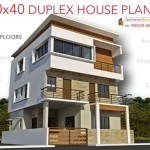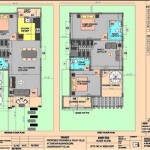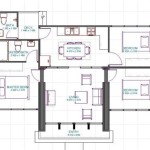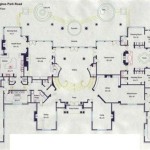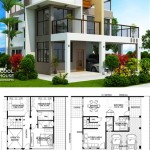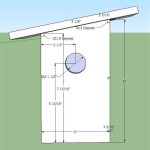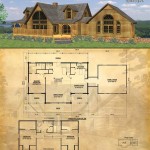Architectural Design Ranch House Plans: A Comprehensive Overview
Ranch house plans represent a significant architectural style that emerged in the United States in the early 20th century and continues to influence residential design today. Characterized by their single-story layout, low-pitched roofs, and open floor plans, ranch houses emphasize comfort, practicality, and a connection to the surrounding landscape. Understanding the core elements and variations within ranch house architecture is crucial for homeowners, architects, and builders seeking to create or renovate a ranch-style dwelling.
This article explores the key features of ranch house plans, examining their historical context, distinct characteristics, popular sub-styles, and design considerations for contemporary applications. The focus rests on providing clear, informative details applicable to both new construction and remodeling projects.
Historical Context and Evolution
The ranch house style's roots can be traced back to the Spanish colonial architecture of the American Southwest. The simplicity, functionality, and integration with the environment found in adobe haciendas resonated with post-World War II Americans seeking affordable and comfortable housing. The first true ranch houses appeared in California during the 1930s, quickly gaining popularity due to their adaptability to the growing suburban landscape. Architect Cliff May is widely credited as a key figure in popularizing the ranch house style, designing homes that emphasized open living spaces and outdoor access.
Following World War II, the demand for affordable housing skyrocketed, leading to the mass production of ranch houses across the country. These homes offered a departure from the more formal and compartmentalized layouts of earlier architectural styles. Their single-story design appealed to families with young children and aging populations alike, offering ease of movement and accessibility. As the style evolved, different regional variations emerged, reflecting the specific climate, materials, and cultural preferences of different parts of the United States.
The initial popularity of the ranch house style waned in the late 20th century, as more elaborate and multi-story designs gained favor. However, in recent years, there has been a resurgence of interest in ranch homes, driven by a renewed appreciation for their simplicity, adaptability, and potential for modern upgrades. Today, ranch house plans are being reinterpreted with contemporary materials, energy-efficient features, and updated layouts to meet the needs of 21st-century homeowners.
Key Architectural Characteristics of Ranch House Plans
Several defining features distinguish ranch house plans from other architectural styles. Understanding these characteristics is essential for identifying and appreciating the unique qualities of ranch homes.
Single-Story Layout: The defining characteristic of a ranch house is its single-story design. This layout eliminates the need for stairs, making it accessible for individuals of all ages and abilities. The horizontal emphasis of the single-story design also contributes to the style's low-profile appearance, blending seamlessly with the surrounding landscape.
Low-Pitched Roof: Ranch houses typically feature low-pitched roofs, further contributing to their horizontal aesthetic. These roofs are often gabled or hipped, with wide eaves that provide shade and protection from the elements. The low pitch minimizes the visual impact of the roof, allowing the house to appear closer to the ground.
Open Floor Plan: One of the most appealing aspects of ranch house plans is the open floor plan. Living spaces, dining areas, and kitchens are often combined into a single, unified space, promoting a sense of spaciousness and facilitating social interaction. This open layout makes ranch houses ideal for entertaining and family gatherings.
Large Windows and Sliding Glass Doors: Ranch houses are designed to maximize natural light and connect the interior spaces with the outdoors. Large windows and sliding glass doors are common features, offering panoramic views of the surrounding landscape and allowing for easy access to patios and gardens.
Attached Garage: The attached garage is another hallmark of the ranch house style. This feature provides convenient access to the house and protects vehicles from the elements. Attached garages are typically located at the front or side of the house, often integrated into the overall design.
Horizontal Emphasis: The overall design of a ranch house emphasizes horizontal lines, creating a sense of stability and groundedness. This horizontal emphasis is achieved through the single-story layout, low-pitched roof, and long, linear facade.
Variations and Sub-Styles within Ranch House Architecture
The ranch house style encompasses a variety of sub-styles, each with its own unique characteristics and regional influences. Recognizing these variations can aid in identifying and appreciating the diversity within ranch house architecture.
California Ranch: Also known as the "Original Ranch," this style is characterized by its simple design, open floor plan, and strong connection to the outdoors. California ranch houses often feature large windows, sliding glass doors, and patios or decks that extend the living space into the garden.
Suburban Ranch: This style represents the mass-produced ranch houses that were built in suburban developments across the United States after World War II. Suburban ranch houses are typically smaller and more standardized than California ranch houses, but they still retain the core features of the style, such as the single-story layout and low-pitched roof.
Split-Level Ranch: This variation features multiple levels that are staggered or offset from one another. Split-level ranch houses provide more living space than traditional ranch houses, while still maintaining a relatively low profile. The split-level design allows for the separation of different living areas, such as the sleeping quarters and the recreational space.
Raised Ranch: Similar to the split-level ranch, the raised ranch features two levels, but the lower level is partially or fully below ground. This design provides additional living space and can be more energy-efficient than traditional ranch houses. Raised ranch houses are often found in areas with sloping terrain.
Rambler Ranch: This style is characterized by its long, sprawling layout. Rambler ranch houses can extend horizontally for considerable distances, often wrapping around courtyards or gardens. The rambler design provides ample living space and a strong connection to the surrounding landscape.
Mid-Century Modern Ranch: This sub-style incorporates elements of mid-century modern design, such as clean lines, minimalist detailing, and an emphasis on natural materials. Mid-century modern ranch houses often feature large windows, exposed beams, and flat or slightly pitched roofs.
Contemporary Ranch: Contemporary ranch houses blend the traditional elements of the style with modern design features. These homes often incorporate sustainable materials, energy-efficient technologies, and updated layouts to meet the needs of contemporary homeowners.
Understanding these different sub-styles allows for a more nuanced appreciation of the ranch house style and its evolution over time. Recognizing the specific characteristics of each variation is also helpful for homeowners who are considering renovating or building a ranch-style home.
When considering ranch house plans, several design considerations are crucial for ensuring a successful outcome. These considerations encompass various aspects of the design process, from site planning to interior layout.
Site Orientation: Proper site orientation is essential for maximizing energy efficiency and creating a comfortable living environment. Consider the sun's path throughout the day and position the house to take advantage of natural light and solar heat gain in the winter, while minimizing heat gain in the summer.
Landscaping: Landscaping plays a crucial role in enhancing the aesthetic appeal of a ranch house and integrating it with the surrounding environment. Choose plants and trees that are appropriate for the local climate and that complement the style of the house. Consider creating outdoor living spaces, such as patios and gardens, to extend the living space beyond the interior walls.
Material Selection: The choice of materials can significantly impact the appearance and performance of a ranch house. Select materials that are durable, low-maintenance, and energy-efficient. Consider using natural materials, such as wood and stone, to enhance the connection with the surrounding landscape.
Interior Layout: The interior layout should be designed to maximize functionality and comfort. Consider the flow of traffic through the house and create distinct zones for different activities, such as cooking, dining, and relaxing. Ensure that there is adequate storage space and that the layout is adaptable to changing needs.
Accessibility: Ranch houses are inherently accessible due to their single-story layout. However, it is essential to consider accessibility features in the design to ensure that the house is comfortable and safe for individuals of all ages and abilities. These features may include wider doorways, ramps, and accessible bathrooms.
Energy Efficiency: Energy efficiency is an important consideration for any new construction or renovation project. Incorporate energy-efficient features into the design, such as high-performance windows, insulation, and HVAC systems. Consider using renewable energy sources, such as solar panels, to reduce the environmental impact of the house.
Sustainability: Sustainability is another important consideration for contemporary ranch house design. Choose sustainable materials, such as recycled content and locally sourced products. Design the house to minimize its environmental impact and to conserve resources.

Plan 77609fb Traditional 3 Bed Ranch House Exclusive New Plans

Trending Ranch Style House Plans With Open Floor Blog Eplans Com

Ranch House Plans Style Home Designs The Designers

Plan 62547dj 3 Bed Modern Ranch House In 2024 Plans

Cova Creek Ranch Home Plans Small House

Plan 18274be Ranch Home With Open Living Area Narrow Lot House Plans Small Cottage Floor

Ranch House Plans Style Home Designs The Designers

Dos Riatas Ranch House Plan Archival Designs

Ranch House Plans Traditional Floor

Ranch Style House Plans

